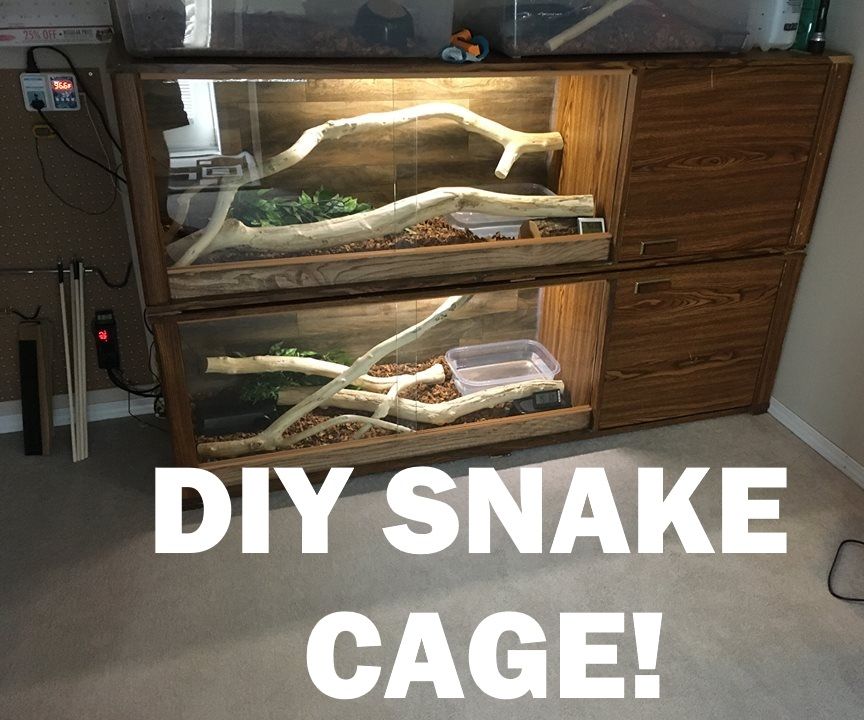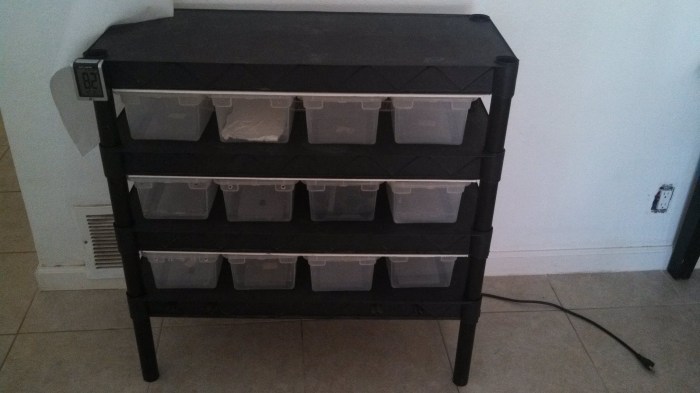DIY Snake Rack: Building a safe and comfortable home for your slithering friend doesn’t have to be a daunting task. This comprehensive guide will walk you through the process of constructing a custom snake rack, from choosing the right materials to ensuring proper ventilation and temperature control.
Creating a DIY snake rack offers several advantages. You can tailor the design to your snake’s specific needs, ensuring a safe and stimulating environment. Additionally, DIY projects can be significantly more cost-effective than purchasing pre-made enclosures, allowing you to invest more in enriching your snake’s habitat.
Ventilation and Temperature Control: Diy Snake Rack

Proper ventilation and temperature control are crucial for maintaining a healthy environment for your snakes. A well-ventilated enclosure prevents the buildup of harmful gases, such as ammonia, while the right temperature range ensures optimal digestion, activity, and overall well-being.
Ventilation Techniques
Adequate ventilation is essential for snake enclosures to prevent the buildup of humidity and harmful gases. Here are some common ventilation techniques:
- Mesh Panels: Mesh panels on the sides or top of the enclosure allow for airflow while still providing visual barriers. These panels can be made from various materials, such as plastic or metal, and can be customized to suit the size and shape of the enclosure.
- Screen Tops: Screen tops are another popular option for ventilation. They provide excellent airflow and allow for easy access to the enclosure. However, ensure the mesh size is small enough to prevent the snake from escaping.
- Ventilation Slots: Ventilation slots can be cut into the sides or bottom of the enclosure to allow for airflow. These slots should be strategically placed to ensure adequate ventilation without creating drafts.
Temperature Regulation
Maintaining the correct temperature range within the enclosure is vital for snake health. This can be achieved using various heating elements and thermostats.
- Heating Pads: Heating pads are placed underneath the enclosure and provide a consistent heat source. They are often used for snakes that prefer to bask and can be adjusted to provide different temperature gradients.
- Heat Lamps: Heat lamps provide radiant heat and are typically used for snakes that need a basking spot. They can be placed above the enclosure and can be adjusted to provide different levels of heat.
- Ceramic Heat Emitters (CHEs): CHEs emit infrared heat and are a popular choice for snake enclosures because they don’t produce light, which can disrupt the snake’s natural sleep cycle. They are often used in conjunction with a thermostat to maintain a consistent temperature.
Heating Sources Comparison
| Heating Source | Advantages | Disadvantages |
|---|---|---|
| Heating Pads | Consistent heat, good for snakes that prefer to bask | Can be difficult to adjust temperature, may not be suitable for all snakes |
| Heat Lamps | Provide radiant heat, easy to adjust temperature | Can produce light, may be expensive to run |
| Ceramic Heat Emitters (CHEs) | Don’t produce light, efficient and cost-effective | Can be difficult to install, may require a separate thermostat |
Substrate and Bedding

The substrate or bedding you choose for your snake’s enclosure is crucial for maintaining a healthy and comfortable environment. It provides a surface for your snake to move around on, helps regulate humidity, and can even offer enrichment opportunities.
Choosing the Right Substrate
The ideal substrate depends on the specific needs of your snake species. Some factors to consider include:
- Humidity Requirements: Some snakes require high humidity levels, while others prefer drier environments. The substrate you choose should help maintain the appropriate humidity levels for your snake.
- Snake Behavior: Consider your snake’s natural behavior and how it interacts with its surroundings. For example, snakes that burrow may need a substrate that allows for digging, while arboreal snakes may benefit from a substrate that provides climbing opportunities.
- Ease of Cleaning: Choose a substrate that is easy to clean and maintain. Frequent cleaning is essential to prevent the buildup of bacteria and parasites.
Popular Substrate Options, Diy snake rack
Here are some common substrates used for snake enclosures:
- Aspen shavings: This affordable and readily available substrate is absorbent and provides good drainage. It’s suitable for snakes that don’t require high humidity. However, it can be dusty, which may irritate some snakes.
- Cypress mulch: Cypress mulch is a good option for snakes that need moderate humidity. It’s also relatively dust-free and can help control odor.
- Coconut coir: This natural fiber is highly absorbent and retains moisture well, making it ideal for snakes that require high humidity. It’s also available in various forms, including bricks, chips, and fiber.
- Reptile bark: Reptile bark is a good choice for arboreal snakes, as it provides climbing opportunities. It’s also relatively absorbent and can help maintain moderate humidity.
- Newspaper: While not as aesthetically pleasing as other substrates, newspaper is a cheap and readily available option. It’s easy to clean and change, but it doesn’t offer any enrichment opportunities.
- Paper towels: Similar to newspaper, paper towels are a sterile and easy-to-clean option. They are often used for quarantine or when a snake is recovering from an illness.
Maintaining Clean and Hygienic Substrate
Keeping the substrate clean and hygienic is crucial for your snake’s health. Here are some tips:
- Spot-clean regularly: Remove any feces, uneaten food, or shed skin daily. This helps prevent the buildup of bacteria and parasites.
- Change the substrate entirely: Depending on the substrate type, you may need to change it completely every few weeks or months. This ensures a fresh and clean environment for your snake.
- Use a substrate that is appropriate for your snake’s needs: Some substrates are more prone to mold and mildew growth, which can be harmful to your snake. Choose a substrate that is specifically designed for reptiles.
Building a DIY snake rack is a rewarding project that allows you to create a personalized and safe environment for your reptile companion. By following these guidelines and utilizing the provided resources, you can confidently construct a comfortable and aesthetically pleasing enclosure that meets your snake’s needs.
Building a DIY snake rack can be a fun and rewarding project, allowing you to create a safe and comfortable habitat for your reptile. While the process might seem daunting, it can be broken down into manageable steps. If you’re looking for inspiration on how to build a frame structure, you might want to check out this guide on creating a DIY photo booth frame.
The principles of frame construction are similar, and you can adapt the techniques to suit your snake rack needs. Once you’ve got the frame sorted, you can focus on the other essential elements like ventilation and heating to ensure your snake’s well-being.
